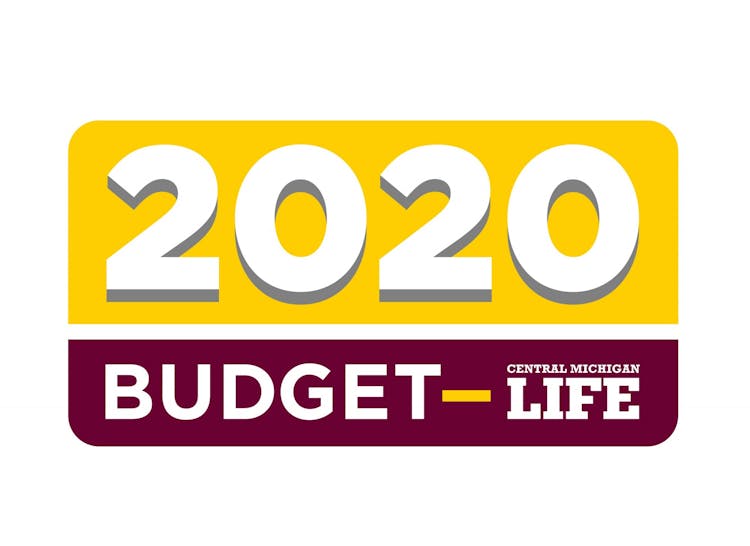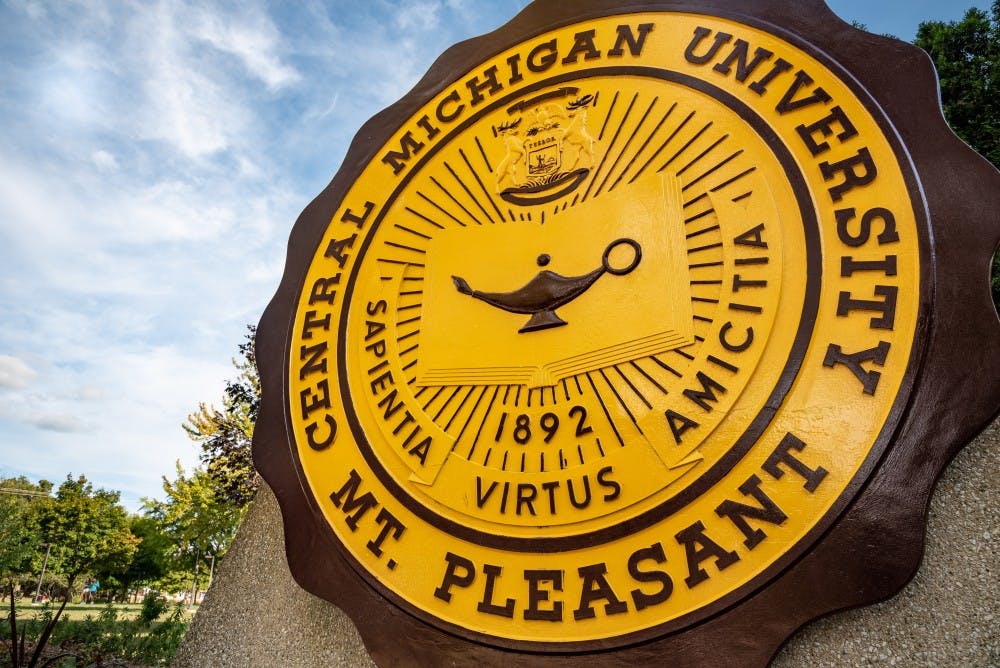BUDGET: University budget decreases by largest margin in decade

(Logo by Madison Skop | Lead Designer)
A 7.3 percent decrease in Central Michigan University’s operating budget has forced university-wide cuts to services, departments and programs.
CMU's 2020- 2021 operating budget has decreased by more than $30 million from last year. There was a 3.3 percent decrease in 2019-2020 and a 1.9 percent decrease in 2018-2019.
Since the 2016-2017 academic year, there has been a 13 percent overall decrease in the CMU’s budget – from $492 million to $428 million, a difference of about $60 million.
The total amount of this year's budget – about $428 million – is the lowest since 2010-2011 when about $418 was budgeted. CMU’s overall budgeted revenue for the 2020-2021 academic year also decreased by almost $30 million from the previous year, a 7.6 percent difference.
The decrease in this year's budget has impacted the entire university. Now about halfway through the fiscal year that began July 1, departments are having to cut costs, personnel within colleges has decreased and services are having to adapt.
Executive Director of Financial Planning and Budgets Joe Garrison said cuts to colleges and departments are decided by prioritizing the value of programs based on student demand, enrollment and cost, among other considerations.
Each department puts forth plans for different levels of reduction, Garrison said. Department chairs and college deans must weigh them against each other to decide what to preserve.
“(Universal) cuts across the board aren’t strategic," Garrison said. “CMU needs to be able to make due with what we have. We are a public entity, so it is our job to be good stewards of the public dollar.”
Each college was forced to scale back. College budgets were reduced by the following:
- The College of Business Administration budget decreased from $23 million to about $21 million, a 7.8 percent difference.
- The College of the Arts and Media budget decreased from $16 million to about $14.8 million, a 7.5 percent difference.
- The College of Education and Human Services budget decreased from $20.6 million to $18.5 million, a 10 percent difference.
- The College of Health Professions budget decreased from $20 million to about $19 million, a 4.8 percent difference.
- The College of Liberal Arts and Social Sciences budget decreased from $28 million to about $25 million, a 10.2 percent difference.
- The College of Medicine budget had the least amount cut from its budget. This year, the college's budget is about $25 million and decreased by about $30,000 from last year. That's a .1 percent difference.
- The College of Science and Engineering budget decreased from about $32 million to $29.6 million, a 7.8 percent decrease.
Budget reductions also impacted the number of personnel within colleges. According to the 2020-2021 operating budget, CMU is down 62 fixed-term faculty and 25 regular and medical faculty members from the 2019-20 academic year.
The decrease is not solely because of lay-offs, however.
Union of Teaching Faculty (UTF) Chief Steward Jason Kennedy said some fixed-term faculty have semester-to-semester contracts and were let go rather than laid off. No more than five of the 62 faculty would have been promoted to tenure tracks, Kennedy said.
“Eliminating positions is very difficult, but it was felt across campus. Some departments felt it more than others," Garrison said. "When two-thirds, or 65 percent, of our budget is people, it is hard to make cuts and not impact people.”
Writing the budget
Creating the university's budget as a “comprehensive process across the entire university,” Garrison said. Multiple university stakeholders take part in drafting the initial models – business managers within colleges, the Office of Academic Planning and Analysis, Service Center leaders, department chairs, and President's Cabinet members, college deans and the Board of Trustees.
Many factors contribute to determining the amount of dollars that make up the projected revenue that is budgeted, Garrison said, including enrollment – transfer credits, size of incoming class and student retention – tuition rates, state funding and auxiliary revenue.
Tuition dollars played a critical role this year, Garrison emphasized, since CMU chose to freeze tuition rates in June. Based on the state’s tuition restraints, Garrison said CMU could’ve generated $8 million more from a tuition increase. Half of the university's budgeted revenue -- about $218 million -- comes from tuition students pay.
Typically, every year from January through April, Garrison and his team model several different scenarios based on tuition rate and other factors. Since things like housing contracts were pushed back, it wasn't until after May 1 that Garrison said the university knew what the magnitude of the reductions would be.
"A budget is a plan. If everything works out according to that plan, great. That would make life easier," Garrison said. "In times like COVID-19, with an election year, there’s a lot of uncertainty.
"This will go down as one of the strangest years CMU will have to deal with."
Garrison said the university acknowledges the economic impacts of the pandemic. However, the university does not attribute this year's budget decrease solely – or directly – to COVID-19.
Executive Director of University Communications Heather Smith said it won't be until after the effects of COVID-19 have passed that CMU can look back and gauge the pandemic's financial impact on the university.
"There were months and months of adapting to years of declining enrollment. Then, we have a global pandemic on top of that," Smith said. "How COVID-19 is affecting CMU's budget is important, but there's a bigger picture than that for the university."
While multiple factors are responsible for this year's reduced budget, Garrison said COVID-19 has compounded budget decreases.
For example, Auxiliary Services is a division made up of money-making services CMU provides. These services include things like residence halls, residential restaurants, the bookstore, university center operations and printing services.
Both the Auxiliary Services total expenditure budget and revenue are expected to decrease by about $8 million, a 13 percent difference from last year. That can be directly attributed to reductions in revenue. One of the Auxiliary Services impacted most by COVID-19 is student housing. Because of lack of student density, fixed costs, utility costs and debt, Residence Life and Auxiliary Services had to pull $3.5 million from the division's reserve funds.
Garrison described the university pulling from reserve funds as an "isolated incident."
Despite the decline in CMU’s budget and budgeted revenue, the university is expecting to receive a slight increase in state appropriations compared to last year.
The $1.78 million increase in state funding is a result of the Michigan Indian Tuition Waiver, a program which waives tuition costs for eligible Native Americans at Michigan community colleges or universities.
The additional funding creates $1.73 million for academic centers and $87,200 for service centers at CMU.
This year, state funding makes up about 20 percent of the overall CMU budget.
“This was certainly an uncertain year for the state when it came to economic effects from COVID-19 for higher education,” Garrison said. “Often times, the state will look at universities as one of the few areas that generates their own revenue through tuition. Other state (agencies) don’t have that capability.”
Looking ahead
Garrison said the university cannot continue operating without significant reductions to services, departments and programs. By making cuts, Garrison said the university is attempting to show fiscal responsibility unlike many other universities that chose to use reserve funds before reductions.
“We can’t be kicking our problems down the road," he said.
There are a number of things the university can due to negate future budget decreases – improve student retention rates, increase overall enrollment, increase its fundraising efforts by reaching out to alumni and expanding non-traditional learning though non-credit professional development, badging and certificate programs.
President Bob Davies holds high hopes as the university makes financial decisions regarding budget reductions, faculty reductions and loss of funding for programs.
"I see CMU continuing to be a shining star, and an example of leadership development among our students," Davies said. "We are going to take on difficult challenges and obstacles while being creative in how to overcome them."







